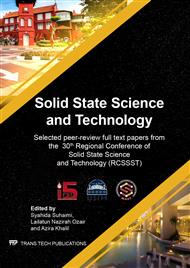[1]
J.W. Yoon, & S.B. Jung, Effect of surface finish on interfacial reactions of Cu/Sn–Ag–Cu/Cu (ENIG) sandwich solder joints, Journal of alloys and compounds. 448(1-2) (2008) 177-184.
DOI: 10.1016/j.jallcom.2006.10.052
Google Scholar
[2]
T.H. Wang, C.H. Tsai, & Y.S. Lai, Effect of the combination of surface finishes and solder balls on JEDEC drop reliability of chip-scale packages, Microelectronic Engineering. 98 (2012) 1-5.
DOI: 10.1016/j.mee.2012.05.001
Google Scholar
[3]
W. Wang, A. Choubey, M.H. Azarian, & M. Pecht, An assessment of immersion silver surface finish for lead-free electronics, Journal of electronic materials. 38(6) (2009) 815-827.
DOI: 10.1007/s11664-009-0761-z
Google Scholar
[4]
N. Mookam, & K. Kanlayasiri, Evolution of intermetallic compounds between Sn-0.3 Ag-0.7 Cu low-silver lead-free solder and Cu substrate during thermal aging, Journal of Materials Science & Technology. 28(1) (2012) 53-59.
DOI: 10.1016/s1005-0302(12)60023-1
Google Scholar
[5]
W.Y.W. Yusoff, N. Ismail, N.S. Safee, A. Ismail, A. Jalar & M.A. Bakar. Correlation of microstructural evolution and hardness properties of 99.0Sn-0.3Ag-0.7Cu (SAC0307) lead-free solder under blast wave condition, Soldering & Surface Mount Technology. 31(2) (2019), https://doi.org/10.1108/SSMT-06-2018-0019.
DOI: 10.1108/ssmt-06-2018-0019
Google Scholar
[6]
W.Y.W. Yusoff, R. Ismail, A. Jalar, N.K. Othman, & I.A. Rahman, Microstructural evolution and micromechanical properties of gamma-irradiated Au ball bonds, Materials Characterization. 93 (2014) 129-135.
DOI: 10.1016/j.matchar.2014.03.024
Google Scholar
[7]
X. Li, X. Yang & F. Li, Effect of isothermal aging on interfacial IMC growth and fracture behavior of SnAgCu/Cu soldered joints, In International Conference on Electronic Packaging Technology and High Density Packaging, ICEPT-HDP (2008) 1-5.
DOI: 10.1109/icept.2008.4607096
Google Scholar
[8]
L.M. Lee & A.A. Mohamad, Interfacial reaction of Sn-Ag-Cu lead-free solder alloy on Cu: A review, Advances in Materials Science and Engineering (2013) 1-11.
DOI: 10.1155/2013/123697
Google Scholar
[9]
K.W. Moon, W.J. Boettinger, U.R. Kattner, F.S. Biancaniello, & C.A. Handwerker, Experimental and thermodynamic assessment of Sn-Ag-Cu solder alloys, Journal of electronic materials. 29(10) (2000) 1122-1136.
DOI: 10.1007/s11664-000-0003-x
Google Scholar
[10]
T. Laurila, V. Vuorinen, & J.K. Kivilahti, Interfacial reactions between lead-free solders and common base materials, Materials Science and Engineering: R: Reports. 49(1-2) (2005) 1-60.
DOI: 10.1016/j.mser.2005.03.001
Google Scholar
[11]
A. Choubey, H. Yu, M. Osterman, M. Pecht, F. Yun, L. Yonghong, & X. Ming, Intermetallics characterization of lead-free solder joints under isothermal aging, Journal of Electronic Materials. 37(8) (2008) 1130-1138.
DOI: 10.1007/s11664-008-0466-8
Google Scholar
[12]
F.J. Chen, S. Yan & Z.G. Yang Failure analysis on electrolytic Ni/Au surface finish of PCB used for wire bonding and soldering,, Soldering & Surface Mount Technology, Vol. 26 Issue: 4, (2014) 180-193, https://doi.org/10.1108/SSMT-10-2013-0026.
DOI: 10.1108/ssmt-10-2013-0026
Google Scholar
[13]
R.R. Chromik, R.P. Vinci, S.L. Allen & M.R. Notis, Measuring the mechanical properties of Pb-free solder and Sn-based intermetallics by nanoindentation, JOM, 55(6) (2003) 66-69.
DOI: 10.1007/s11837-003-0144-5
Google Scholar
[14]
J. Alkorta, J.M. Martinez-Esnola & J.G. Sevillano. Critical examination of strain-rate sensitivity measurement by nanoindentation methods – application severely deformed niobium. Acta Mater 56 (2008) 884-893.
DOI: 10.1016/j.actamat.2007.10.039
Google Scholar
[15]
O.N. Ignatova, I.I. Kaganova & A.N. Malyshev, Effect of shock-wave on the internal structure and mechanical properties of fine-grained copper, Combustion Explosion and Shock Wave 46(6) (2010) 719-723.
DOI: 10.1007/s10573-010-0096-3
Google Scholar
[16]
Y. Tang, S. M. Luo, W. F. Huang, Y. C. Pan, G. Y. Li, Effects of Mn nanoparticles on tensile properties of low-Ag Sn-0.3Ag-0.7Cu-xMn solder alloys and joints. Journal of Alloys and Compounds, 719 (2017) 365-375.
DOI: 10.1016/j.jallcom.2017.05.182
Google Scholar


